TIXALL MEWS - Grade II:-
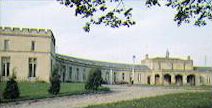 The early 19th century stables for the Georgian Hall at Tixall, built
by Thomas Clifford. They are built of local sandstone with mullioned
windows and a slate roof.
The early 19th century stables for the Georgian Hall at Tixall, built
by Thomas Clifford. They are built of local sandstone with mullioned
windows and a slate roof.
In 1833 they
were described as lately built of stone at great expense, forming a
crescent behind, and at a short and convenient distance from the house.
The centre is two
storeyed, embattled and with a Gothic portico. It originally
served as the coach house for 10 carriages and has vaulted cellars. On
either side are the ranges of originally single storied, stables which
had stalls for 40 horses, with a two storied embattled tower at either
end for grooms, coachmen
and other servants. The buildings were converted to residential use in
the
1970s.
THE BOTHIE AT TIXALL MEWS - Grade
II:- 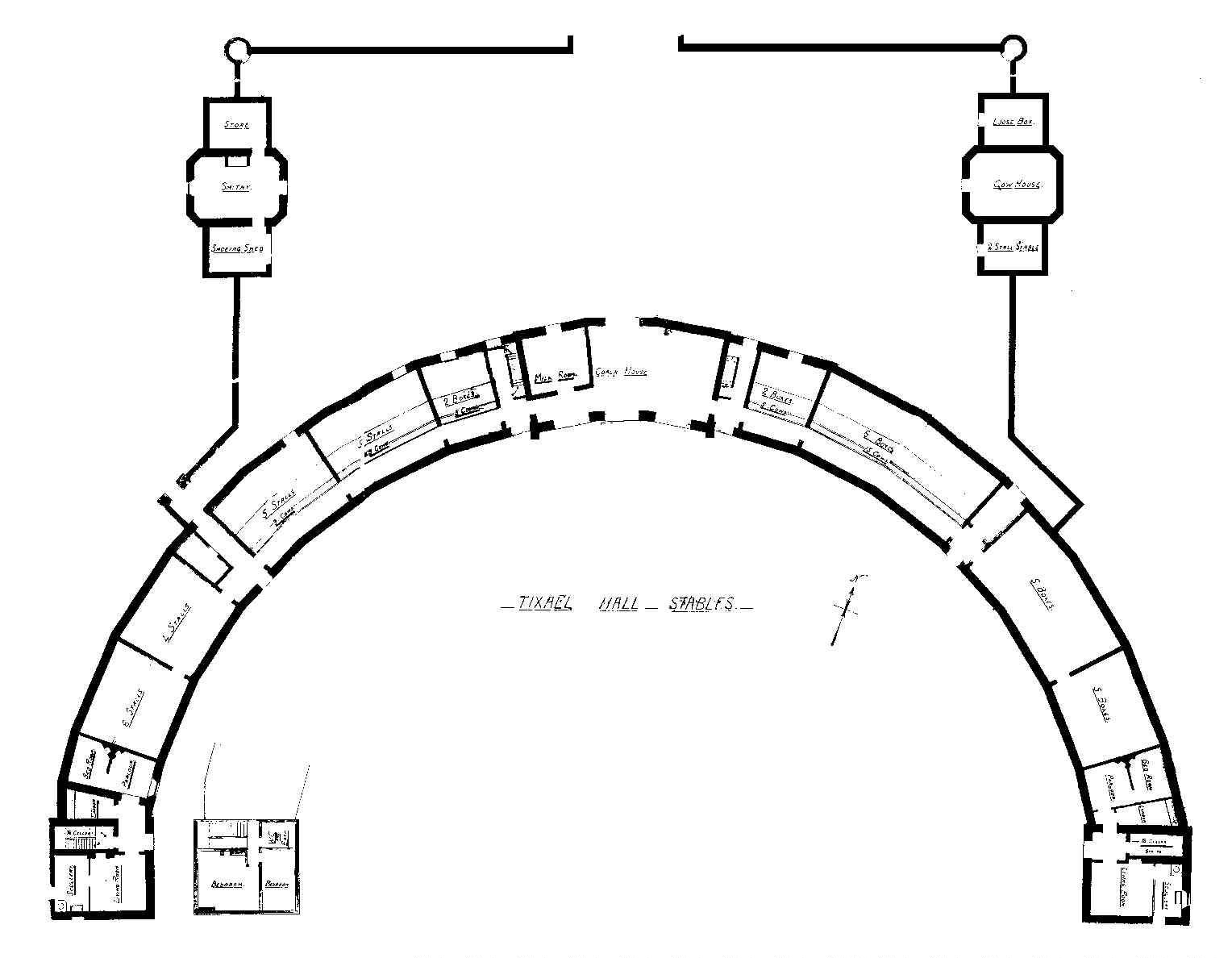
This was
originally one of a pair of buildings behind the stables, called garden
houses in
the official listing description, but probably used to house servants
or
agricultural labourers.The other building was demolished to make room
for
a potatoe store by a previous owner.
TIXALL FARM - Grade II:-
The brick
farmhouse and farm-buildings were listed when they were sold for
development in
the 1980s. They are a good example of an early 19th or late
18th
century purpose-built model farm.
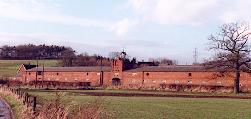 Originally there
was a long range of roadside buildings with a central entrance tower
and
dovecote, leading to an enclosed yard surrounded by barns and other
single
storey buildings, leading through a further archway up the hill to the
farmhouse behind.
Originally there
was a long range of roadside buildings with a central entrance tower
and
dovecote, leading to an enclosed yard surrounded by barns and other
single
storey buildings, leading through a further archway up the hill to the
farmhouse behind.
The yard used to
contain additional buildings including a large cowshed, which were
demolished when the buildings were converted to residential use in the
1990s.
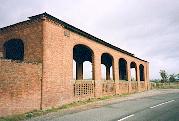
Prominent beside the road at the east end is a
large an impressive contemporary "Dutch" barn with 5 brick arched
openings.
BOTTLE LODGE - Grade II:-
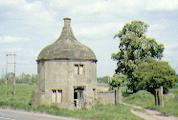 This is a curious octagonal lodge in
ashlar stone with an ogee stone vaulted roof. There is a central stone
chimney, moulded stone eves, mullioned windows and a cambered stone
doorway. This is a curious octagonal lodge in
ashlar stone with an ogee stone vaulted roof. There is a central stone
chimney, moulded stone eves, mullioned windows and a cambered stone
doorway.
The building stands at
the roadside opposite Tixall Farm, at the Tixall end of the bridleway
connecting Tixall to Great Haywood, where the Astons and Cliffords held
further land and property. Bottle Lodge was previously known as the
Upper Lodge, with the Lower or White Lodge, at the Haywood Mill end of
the Bridleway.
The chimney was
straightened when the building was restored a few years ago for use as
rented accommodation, with single rooms upstairs and downstairs. In the
19th century it was
used to house the local shepherd with his children sleeping in the
farmbuildings on the other side of the road.
THE TEMPLE OR ROTUNDA - Grade II:-
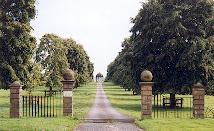 This originally stood in the Wood Field at Ingestre, and was
moved to Tixall in the 1960s when the Ingestre Estate was sold. It has
been attributed to Capability Brown, who is known to have carried out
work at Ingestre in the mid 18th century. It is described as an open,
stone, domed structure of octagonal plan with Doric or Tuscan columns
and enriched entablature. This originally stood in the Wood Field at Ingestre, and was
moved to Tixall in the 1960s when the Ingestre Estate was sold. It has
been attributed to Capability Brown, who is known to have carried out
work at Ingestre in the mid 18th century. It is described as an open,
stone, domed structure of octagonal plan with Doric or Tuscan columns
and enriched entablature.
TIXALL OBELISK - Grade II (An
Ancient Monument):-
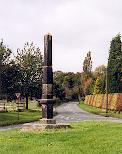
A hexagonal sandstone obelisk with
a stepped base, inscribed with the date 1776 and Stafford 3½
miles, it also gives mileages to Lichfield and London. It was
probably erected when Thomas Clifford re-routed the road which used to
run straight through the village on the edge of Tixall Park, to the
south around the outside of his new walled garden.
TIXALL HOUSE - Grade II (formerly
Tixall Cottage):-
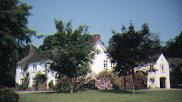 A
colourwashed brick building in the local Regency manner with tiled roof
, brick chimneys and casement windows. The central door has a wood
bracketted hood and a rectangular fanlight. It is thought to date from
the early 19th century. A
colourwashed brick building in the local Regency manner with tiled roof
, brick chimneys and casement windows. The central door has a wood
bracketted hood and a rectangular fanlight. It is thought to date from
the early 19th century.
The extensive gardens
include the old walled garden and glasshouses of the 18th century hall,
and are bounded by a high beech hedge.
TELEPHONE KIOSK IN TIXALL VILLAGE -
Grade II:-
This is an example of the K6 type
telephone kiosk, designed in 1935 by Sir Giles Gilbert Scott and made
by various contractors in cast iron. It is a square kiosk with a domed
roof, decorated with unperforated crowns at the top of the panels.
DAIRY BRIDGE - Grade II:-
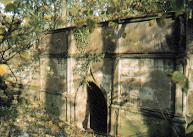 An
ashlar faced bridge with a single small Gothic arch, moulded pilasters
on both sides and a heavy coped
parapet. On the east side is the inscription "HIC VER PERPETUUM" - Here
everlasting spring. It is thought to be 18th century, built by Thomas
Clifford as part of his reorganisation of the estate to serve as a
carriage
route to the hall, over a walkway to his new walled gardens. An
ashlar faced bridge with a single small Gothic arch, moulded pilasters
on both sides and a heavy coped
parapet. On the east side is the inscription "HIC VER PERPETUUM" - Here
everlasting spring. It is thought to be 18th century, built by Thomas
Clifford as part of his reorganisation of the estate to serve as a
carriage
route to the hall, over a walkway to his new walled gardens.
HOLDIFORD BRIDGE - Grade II:-
An ashlar bridge over the
River Sow with 3 spans and segmental arches, the central higher than
the others. There are moulded stringcourses on both sides.
Holdiford Road
originally crossed the river below the Dark Lantern at Shugborough and
passed near what is now Lock Farm. The river crossing was moved at the
request of Thomas Anson, and at the expense of the Staffordshire &
Worcestershire Canal Company when the canal was built in 1772.
BRINDLEY'S AQUEDUCT - Grade II:-
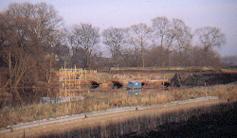 A
four span stone aquedauct with segmental arches carrying the
Staffordshire & Worcestershire Canal
over the River Sow to the west of Holdiford Bridge. The stone is
reputed
to have come from the small quarry at the entrance to Old Hill in
Holdiford road. A
four span stone aquedauct with segmental arches carrying the
Staffordshire & Worcestershire Canal
over the River Sow to the west of Holdiford Bridge. The stone is
reputed
to have come from the small quarry at the entrance to Old Hill in
Holdiford road.
The aqueduct was
originally built on dry land to the south of the river, and the river
was then diverted under it.
The World War II
concrete pill-box at the south was removed some years ago when the
aqueduct
was restored by British Waterways.
THE VILLAGE HALL formerly TIXALL
CHURCH SCHOOL:-
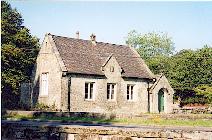 The village hall is not listed but stands within the Conservation Area
in the centre of the village opposite the church. It was built in 1850
on land given by Lord Shrewsbury. The school closed in the early 1900s
and in the 1950s the building was extended
with the addition of a kitchen, internal toilets and a committee room.
It
is currently being renovated to serve as the Village Hall for both Tixall and
Ingestre.
The hall is available for hire.
The village hall is not listed but stands within the Conservation Area
in the centre of the village opposite the church. It was built in 1850
on land given by Lord Shrewsbury. The school closed in the early 1900s
and in the 1950s the building was extended
with the addition of a kitchen, internal toilets and a committee room.
It
is currently being renovated to serve as the Village Hall for both Tixall and
Ingestre.
The hall is available for hire.
THE STONE SEATS ON TIXALL ROAD:-
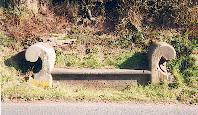 These seats are now listed, and lie
outside the Conservation Area.They were erected in memory of Thomas
Hartshorne who built and lived at the new Brancote Farm, replacing the
Old Farm nearer the river. He had put up wooden seats for travellers to
rest on on their way to and from Stafford. These seats are now listed, and lie
outside the Conservation Area.They were erected in memory of Thomas
Hartshorne who built and lived at the new Brancote Farm, replacing the
Old Farm nearer the river. He had put up wooden seats for travellers to
rest on on their way to and from Stafford.
|